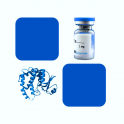
- Remove this product from my favorite's list.
- Add this product to my list of favorites.
Products
Viewed products
Newsletter
 |  |  |  |  |  |

Background
Granulocyte Colony Stimulating Factor Receptor (G-CSFR), also known as Cluster of Differentiation 114 (CD114), CSF3R and GCSF, is a cell-surface receptor for the granulocyte colony-stimulating factor (G-CSF), a cytokine that plays a critical role in the regulation of the activation, proliferation, differentiation, and survival of the neutrophilic granulocyte lineage. G-CSFR belongs to a family of cytokine receptors known as the hematopoietin receptor family. This type I? membrane protein has a composite structure consisting of an immunoglobulin(Ig)-like domain, a cytokine receptor-homologous (CRH) domain and three fibronectin type I II (FNIII) domains in the extracellular region. G-CSFR is present mainly on precursor cells in the bone marrow, and, in response to stimulation by G-CSF, initiates cell proliferation and differentiation into mature neutrophilic granulocytes and macrophages. G-CSFR mediates the specific effect of GCSF through activating a variety of intracellular signaling cascades, including the Jak/Stat, PI3/Akt, Ras-Raf-MAP kinase, and Src family kinase pathways, and thus functions in defense against infection, inflammation and repair, and in the maintenance of steady state hematopoiesis. Mutations in this gene are a cause of Kostmann syndrome, also known as severe congenital neutropenia. Mutations in the intracellular part of this receptor are also associated with certain types of leukemia.
Source
Recombinant Human GCSFR /CD114 Protein (rhGCSFR), His Tag (GCR-H5223) is expressed from human 293 cells (HEK293). It contains AA Glu 25 - Pro 621 (Accession # NP_000751.1).
Predicted N-terminus: Glu 25
Molecular Characterization
This protein carries a polyhistidine tag at the C-terminus.
The protein has a calculated MW of 67.4 kDa. The protein migrates as 80-90 kDa under reducing (R) condition (SDS-PAGE) due to glycosylation.
Endotoxin
Less than 1.0 EU per μg by the LAL method.
Purity
>95% purity as determined by SDS-PAGE.
Formulation
Lyophilized from 0.22 μm filtered solution in PBS, pH7.4 with trehalose as protectant.
Reconstitution
Please see Certificate of Analysis for specific instructions.
For best performance, we strongly recommend you to follow the reconstitution protocol provided in the CoA.
Storage
For long term storage, the product should be stored at lyophilized state at -20°C or lower.
Please avoid repeated freeze-thaw cycles.
This product is stable after storage at:
-20°C to -70°C for 12 months in lyophilized state;
-70°C for 3 months under sterile conditions after reconstitution.
Bioactivity
Please refer to product data sheet.
(1) "CD34+ cell yield among healthy donors: Large-scale model development and validation"
Alswied, Daniel, Chen et al
J Clin Apher (2024) 39 (3), e22135
(2) "Shorter donor leukocyte telomere length is associated with poor peripheral blood stem cell mobilization induced by granulocyte colony-stimulating factor"
Yang, Liu, Wang et al
J Formos Med Assoc (2024)
(3) "A case of successful CAR-T cell therapy for early isolated CNS recurrence of DLBCL with persistent CAR-T cells"
Takigawa, Kawano, Mori et al
Blood Cell Ther (2024) 7 (2), 37-40
Showing 1-3 of 2290 papers.
Follow us